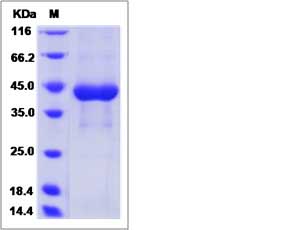Rhesus DC-SIGN / CD209 Protein(His Tag)
CD209,DC-SIGN
- 100ug (NPP2946) Please inquiry
| Catalog Number | P90319-C07H |
|---|---|
| Organism Species | Rhesus |
| Host | Human Cells |
| Synonyms | CD209,DC-SIGN |
| Molecular Weight | The recombinant rhesus CD209 consists of 339 amino acids and predicts a molecular mass of 38.8 kDa. |
| predicted N | His |
| SDS-PAGE |  |
| Purity | > 95 % as determined by SDS-PAGE. |
| Protein Construction | A DNA sequence encoding the rhesus CD209 (AAK74185.1) (Lys62-Glu381) was expressed with a polyhistidine tag at the N-terminus. |
| Bio-activity | |
| Research Area | Cancer |Invasion microenvironment |Adhesion molecule |Cell adhesion |Lectin |C-tyep lectin | |
| Formulation | Lyophilized from sterile PBS, pH 7.4. 1. Normally 5 % - 8 % trehalose and mannitol are added as protectants before lyophilization. Specific concentrations are included in the hardcopy of COA. |
| Background | Dendritic cell (DC)-specific intercellular adhesion molecule 3 (ICAM-3) grabbing nonintegrin (DC-SIGN), also known as CD209, is a type II transmembrane protein on DCs with a C-type lectin extracellular domain, is capable of binding ICAM-3 on resting T cells in the secondary lymphoid organs, providing the initial contact between these cells during the establishment of cell-mediated immunity. It is not only a pattern recognition receptor but implicated in immunoregulation of DCs. It has important role in mediating DC adhesion, migration, inflammation, activating primary T cell, triggering immune response and participating in immune escape of pathogens and tumors. DC-SIGN also mediates capture and internalization of viral, bacterial, and fungal pathogens by dendritic cells, such as HIV-1, Ebola virus, cytomegalovirus, Dengue virus, and hepatitis C virus. DC-SIGN is unique in that it regulates adhesion processes, such as DC trafficking and T-cell synapse formation, as well as antigen capture. Moreover, even though several C-type lectins have been shown to bind HIV-1, DC-SIGN does not only capture HIV-1 but also protects it in early endosomes allowing HIV-1 transport by DC to lymphoid tissues, where it enhances trans infection of T cells. |
| Reference |
